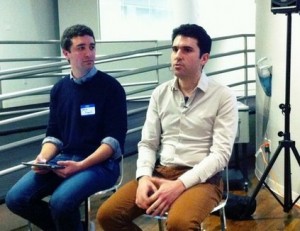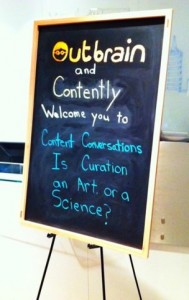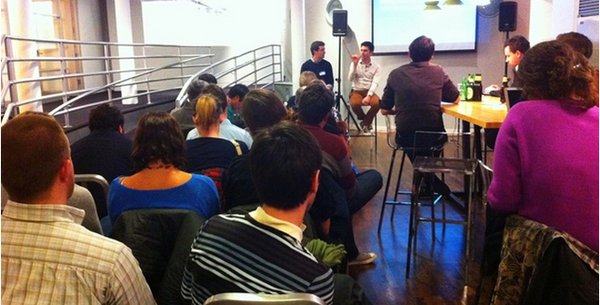Brands
The Art and Science of How Techmeme Curates News
Throughout the discussion about Techmeme at Content Conversations in New York this week, the relationship between algorithms and human curators when it comes to publishing stories was a constant theme.

Steve Kovach and Gabe Rivera at the meetup
How do they intersect? What happens when they overlap?
Wednesday’s Outbrain-hosted meet-up, “Is Curation an Art or a Science? A Discussion with Techmeme’s Gabe Rivera,” was co-sponsored by Outbrain and Contently.
Rivera, founder and CEO of the seven-year-old technology-news aggregator, spent much of his time answering questions about the decision-making and inner workings of his business, but almost every path led back to the question: Is Techmeme weighted toward automation or is it curated with a human touch?
At times, under questioning by Steve Kovach, editor at Business Insider SAI, the talk turned specific. Listening to the discussion, one heard the story of how content evolves across a day at Techmeme’s offices.
Teasing Out the Thread
Kovach wanted to know why his own recent breaking-news story about the fate of Groupon CEO Andrew Wilson was replaced hours later by someone else’s article on the subject on Techmeme.
 “I imagine you wrote that very quickly because the news was breaking, and you then moved on to do a thousand other things,” Rivera said of Kovach’s piece on Wilson (who faced some potentially bad news about his post with Groupon on Nov. 28). “And I would guess [the writer of the other article] had more time to write, and maybe he added more context.”
“I imagine you wrote that very quickly because the news was breaking, and you then moved on to do a thousand other things,” Rivera said of Kovach’s piece on Wilson (who faced some potentially bad news about his post with Groupon on Nov. 28). “And I would guess [the writer of the other article] had more time to write, and maybe he added more context.”
“At some point, maybe an hour later, maybe the automation was pushing up Peter’s thing,” Rivera said he suspected that the site’s automation began to favor the secong article over Kovach’s piece. “Perhaps our editors looked at it, too, and said, ‘Maybe at this point, the story’s more built out, and we can just do the swap,'” he said.
The process that Rivera describes is, then, sympathetic. The effect of an editor taking up a question of which story to run arises in response to a computers hauling news up to the top of a site’s front page. Human editors then assess and make decisions about what pieces of writing are the best account of an issue.
Curating Without Complicating
The bootstrapped and still self-financed world of Techmeme is very much Rivera’s baby. Kovach pressed Rivera about what stamp the founder might put on the news that the site carries.
For instance, headlines are treated in a particular way at Techmeme — presenting them in exactly the way they’re written by the sources that the site scrapes. To the extent that sometimes, Rivera said, a better story on a given topic gets passed over for a lesser work that carries what the staff evaluates to be a better title.
“As soon as we change a headline to show our own words, it gets complicated,” he said. “Do we change the titles of everything, or just some things? And if it’s some things, I think it detracts from the purity and simplicity of the product. Publishers can complain that we’re not representing what they’re doing. Some publishers might even see that as competition.”
And so, when it comes to curation, Techmeme’s staff keeps their creativity out of presenting content.

On Point: Science and Art of Curation
Asked about the interaction of humans and algorithms, when it comes to the content on Techmeme — not that the two are entirely separate (somebody builds an algorithm, after all) — Rivera had the following to say about what might be a dividing line: “A general trend that I’ve noticed: where humans and algorithms come together very often it ends up structured so that algorithms make suggestions to some trained intermediate group of people who then promote or publish.”
The algorithms transform very raw data into what the readers see, he continued. A human hand need to complete the transaction, he said.
“Describe any algorithm for promoting stuff, and you’ll come up with a lot of scenarios where it can go wrong,” Rivera said. “That’s where humans will need to step in. That’s the approach that we took.”
Images courtesy of Erica Swallow
Get better at your job right now.
Read our monthly newsletter to master content marketing. It’s made for marketers, creators, and everyone in between.




